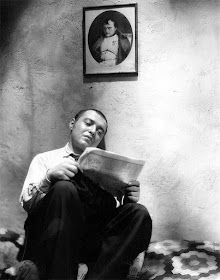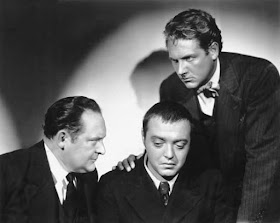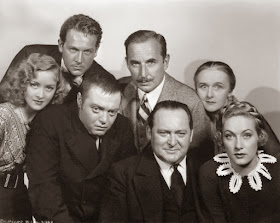 ‘Arrow Academy’ have recently released a digitally enhanced version of the 1935 classic, ‘Crime and Punishment’. It was directed by Josef von Sternberg; it starred Peter Lorre, Edward Arnold, and Marian Marsh; and it lasts for 88-minutes. Plus, as an extra added bonus, the Blu-ray edition comes with a visual essay narrated by David Thompson, a German documentary about Peter Lorre, a radio adaptation broadcast in 1947, an image gallery, as well as an isolated music and effects track. Please enjoy.
‘Arrow Academy’ have recently released a digitally enhanced version of the 1935 classic, ‘Crime and Punishment’. It was directed by Josef von Sternberg; it starred Peter Lorre, Edward Arnold, and Marian Marsh; and it lasts for 88-minutes. Plus, as an extra added bonus, the Blu-ray edition comes with a visual essay narrated by David Thompson, a German documentary about Peter Lorre, a radio adaptation broadcast in 1947, an image gallery, as well as an isolated music and effects track. Please enjoy.Crime and Punishment [Arrow Academy]
THE STORY:
Between you and me, I’ve been fairly fascinated by crime for most of my life. In fact, I’ve been so fascinated by the subject, that I studied crime, I wrote about crime, and despite my better judgment, I even committed a crime.
You see, not so long after my graduation, both my family and I found ourselves facing severe financial hardship. So in order to dig ourselves out of poverty, we tried our best to do something about it. Initially, this involved my sister Antonya (Tala Birell) getting engaged to a rich man so we could look after our mother, Mrs. Raskolnikov (Elisabeth Risdon). But when that didn't work out as we hoped it would, I then decided to take matters into my own hands by tricking, stealing, and killing a cruel yet affluent pawnbroker!
Well, what else could I do? I was desperate, really desperate, because I quickly needed some money so I could pay my landlady everything I owed her. Otherwise, I would have been homeless, abandoned, and destitute, similar to my good friend Sonya (Marian Marsh).
But then again, that’s most probably why what next transpires goes from bad to worse, when a policeman suddenly shouts out my name, Roderick Raskolnikov (Peter Lorre), before asking me to go down to the station with him. As a ghastly crime is plagued by doubt - a culprit does the twist and shout - a cast of characters avoids freaking out - and at the end of the day, please remember, religion and politics aren't always devout.
THE REVIEW:
In many ways, ‘Crime and Punishment’ is a morality tale about a smart individual who allows his ego to impede his better judgment. Although, on second thoughts, maybe the word 'smart' isn’t exactly the correct word to use? After all, the individual in question, Roderick, isn’t just smart, because he’s also an arrogant, nervous, and schizophrenic academic, whose emotions ebb and flow like the changing of the tides.
You see, from a certain point of view, this movie is about the follies of humankind and the sorrows of sin. While, from another perspective, it’s a straightforward crime drama that’s been carefully constructed within a three-act play. Act One, for instance, establishes most of the main characters and sets up the initial part of the plot (i.e. a desperate man that kills a pawnbroker because he has no money). Whereas Act Two, on the other hand, instigates a game of cat and mouse between the hunter and the hunted, while simultaneously redefining certain relationships among the cast. And as for Act Three? Well, to some extent, it’s a resolution of sorts, a resolution in which both logic and emotion finally come together to form a finale that absolves the main character of his sins.
Although, come to think of it, maybe the word 'absolves' isn’t the correct word to use either? Especially if you take into account that this story was based on a 656 page novel -- I repeat, a 656 page novel -- and condensed to fit a fairly primitive screenplay that’s one part crime drama and one part psychological thriller. So, as you can imagine, some things were ‘lost in translation’ and directly affected the overall flow of the narrative.
For example, near the end of the film, we were introduced to a new character that’s in love with Antonya, Roderick's sister, even though it was never made clear where he comes from, why he turned up at this precise moment in time, or why nobody else has mentioned him before this part of the plot! Similarly, those scenes featuring Sonya, Roderick's love interest, sometimes felt fairly fractured within the scheme of things, as if they were seemingly relegated to tokenism instead of an integral slice of the story.
Now, where the visual look of this film is concerned, more or less, I’d say it had a stark and foreboding tone that complemented the mood it wanted to convey. Stylistically, this included things like sparsely furnished bedrooms, sterile-looking offices, and a dress sense that ranged from rather elegant to rather drab, depending on the situation. What’s more, each scene was also elegantly lit to emphasize a plot point or a character’s true motivations, almost as if an undulating shadow or a flash of bright light could denote the innermost workings of a person's mind.
Anyway, that’s enough of that for the time being, because now I think we should sit back, relax, and check out the following filmic facts: (1) ‘Columbia’ first released this picture in New York, New York, on the exact same day Mussolini sent 100,000 troops to work in the agricultural industry in order to combat the effects of sanctions. It was on the 21st of November, 1935, and they had to work for three solid months. (2) According to Peter Lorre’s daughter, Catharine, her father initially brought this project to the studio because he was a big fan of the Fyodor Dostoevsky novel. Allegedly, both he and an unnamed woman wrote a two-page outline so Harry Cohn and his cronies didn’t have to read the lengthy 1866 original. (3) Loosely translated, this project was entitled ‘Remorse’ in France, ‘Raskolnikov’ in Austria, and ‘I Have Killed!’ in Italy. (4) One of the taglines used to promote this picture, states, ‘A Great Masterpiece Becomes a Greater Picture! Thrilling audiences as it has thrilled millions of readers!’. (5) The majority of this movie was shot inside ‘Columbia/Sunset Gower Studios’, located on 1438 North Gower Street, Hollywood, Los Angeles. (6) Depending on who you listen to, there were three main reasons why this movie was ultimately made. Firstly, the story was in the public domain and required no copyright fees. Secondly, the studio wanted to capitalize on Peter Lorre’s success with ‘Mad Love’ as well as Von Sternberg’s previous collaborations with the actress, Marlene Dietrich. And thirdly, adapting classical literature was very trendy in Hollywood at the time, the 1930s, and so those people behind this project decided to cash-in on it as well. (7) Josef von Sternberg was contractually obligated to direct this film but didn’t really like it. In his autobiography, ‘Fun in a Chinese Laundry’, he said that it was "no more related to the true text of the novel than the corner of Sunset Boulevard and Gower is related to the Russian environment." (8) To follow on from my previous point, and you might like to know that the son of Josef von Sternberg, Nicholas Josef von Sternberg, would eventually work as a cinematographer on the 2002 remake of this cinematic adaptation.
In closing my review of ‘Crime and Punishment’, I would just like to say how much I enjoyed watching some of the performances given by the cast. Marian Marsh, for instance, is just delightful at playing Sonya due to her angelic face, her pleasant demeanor, as well as the way she composes herself regardless of the situation. Whereas Edward Arnold, on the other hand, plays Inspector Porfiry as if he were a bumbling buffoon who’s both irritating and dramatic at any given turn. And as for Peter Lorre? Well, what can I say about him? Apart from the fact that his performance was so intense, so mannered, and so cerebral within its execution, sometimes I almost forgot that he was sharing the screen with other people! Seriously, folks, nigh on everyone else felt fairly flat in comparison, because he came across as an intellectual thug with a Napoleon complex and a bipolar temperament. Bipolar, being the operative word in this case, for both the tone of the film, the style of the film, as well as what it wanted to say!
I mean, let’s face it, at the heart of it all was a man that was corrupted by the inequities between academia and everyday life. A man, I hasten to add, that left university presuming that he would be able to get a job in his chosen field and live a good and healthy life from that moment onwards. But as we all know, this isn’t always the case, is it? No, unfortunately not, and sometimes certain people have to adapt to the numerous situations they end up facing! Otherwise, they will turn out like Roderick -- poor, little Roderick -- and find themselves trapped between a rock and a hard place, waiting to get squashed.
Anyway, all that aside, on the whole, I’d say this movie wasn’t all that bad, and I would definitely recommend it to those people who like watching psychological thrillers, crime dramas, and theatrical films that are more cerebral than the norm.
THE RATING: C
CRIME AND PUNISHMENT (1935)
 Reviewed by David Andrews
on
July 29, 2019
Rating:
Reviewed by David Andrews
on
July 29, 2019
Rating:
 Reviewed by David Andrews
on
July 29, 2019
Rating:
Reviewed by David Andrews
on
July 29, 2019
Rating:









No comments:
Post a Comment